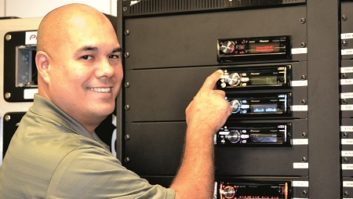
This slide from Toyota discussed a potential 30-character limit based on Japan Automobile Manufacturers Association guidelines. NHTSA ultimately replaced a proposed character limit for displayed text with a recommendation against displaying any text from books, periodical publications, Web page content, social media content, text-based advertising and marketing or text-based messages. Source: NHTSA
WASHINGTON — The National Highway Traffic Safety Administration has released visual-manual driver distraction guidelines for electronic devices in vehicles. The NHTSA, part of the Department of Transportation, issued these nonbinding, voluntary guidelines to promote safety by discouraging the introduction of “excessively distracting devices in vehicles.”
They apply to original, in-vehicle electronic devices used by the driver to perform secondary tasks — the driver looks at a device, manipulates a device-related control with his or her hand and/or watches for visual feedback. Communications, entertainment, information gathering and navigation fall under this umbrella.
Although the guidelines apply to new technology, they also are applicable to common electronic devices referred to as “conventional information or communications systems,” such as AM/FM radios, satellite radios, CD players, cassette players and MP3 players.
The NHTSA believes some secondary tasks interfere with a driver’s ability to control the car safely. Two examples would be displaying video or scrolling text. The guidelines recommend these devices be designed to “lock out” the driver at a certain point if the vehicle is moving.
The guidelines include a test for manufacturers to measure eye glance behavior during those tasks, and determine whether it’s safe to perform such actions while driving and whether equipment necessary to complete the tasks should be modified. You can find the 281-page guidelines on the NHTSA website www.nhtsa.gov and on DOT’s distracted driving website distraction.gov.
The NHTSA guidelines are based on certain fundamental principles. NHTSA believes the driver’s eyes should be looking ahead at the road and be able to keep “at least” one hand on the steering wheel while performing a secondary task. The distraction induced by any secondary task performed while driving should not exceed that associated with a baseline reference task, like manual radio tuning.
Any task performed by a driver should be interruptible at any time, and the driver, not the system/device, should control the pace of task interactions, according to NHTSA.
Activities the NHTSA considers distracting include displaying video not related to driving, automatically scrolling text, large amounts of static text for reading and manual text entry. It does not mean to block simple map displays and related text, so long as the material is “displayed in a safe manner.”
COMPLEX INTERFACES
Congress is looking at the future of the car in general, and at the dashboard specifically.
“The first thing someone in a car should do is drive,” said David Strickland, administrator of the National Highway Traffic Safety Administration, during a recent Senate Commerce Committee hearing on future car technologies.
The NHTSA wants drivers to be able to accomplish tasks quickly, to avoid distraction — “the equivalent of handling a radio in a car,” Strickland said.
However, even these conventional systems can potentially distract drivers and present a safety risk, and, as in-vehicle systems continue to offer more functionality, the interfaces for these conventional systems could become more complex and potentially more distracting in the future, according to NHTSA.
New guidelines are needed to incorporate the latest driver distraction research since the recommendations were last updated seven years ago, says NHTSA. Some of the recent research suggests improvements can be made. For example, the eye glance test protocol uses radio tuning as a reference task to establish the maximum recommended threshold for what it calls “Total Eyes-Off-Road Time” or TEORT, to complete an action. New research results suggest that the best TEORT associated with radio tuning should be 12 seconds; that’s more stringent from the previously accepted 20 seconds.
Recent NHTSA research found “substantial” differences in Total Eyes-Off-Road times for drivers tuning a radio depending on what vehicle model was used. During tuning testing using five vehicles, some with knob and others button tuning, Total Eyes-Off-Road times ranged from 8 to 15.8 seconds.
NHTSA is concerned that the driver interfaces of conventional electronic devices can, with modern electronics, be made far more distracting than they have been in the past. NHTSA does not believe that, for example, a future in-vehicle radio that shows video clips as it plays music should still be considered in conformance with the NHTSA Guidelines simply because a radio is a conventional electronic device.
During the hearing, Committee Chairman Jay Rockefeller, D-W.Va., expressed concern about the distractions inherent in turning cars into virtual “rolling offices.” Strickland said NHTSA does not accept that concept; rather, NHTSA wants to lock out such activities as having the driver read large amounts of text on a screen. It’s okay to have that text transcribed and read to you, Strickland explained, because that’s “like a radio.”
Asked for comment, Valerie Shuman, vice president of industry programs for the Connected Vehicle Trade Association, said in NHTSA’s ideal world, people would just drive. However, realizing there are distractions, NHTSA tries to measure what looks to be the best possible set of metrics.
“I think radio gets used as an example because the interface is something people are extremely used to … It doesn’t take much time to hit the knob on a radio,” said Shuman. “You aren’t looking at this big, fancy screen” or “clicking through 17 layers of functionality.”











